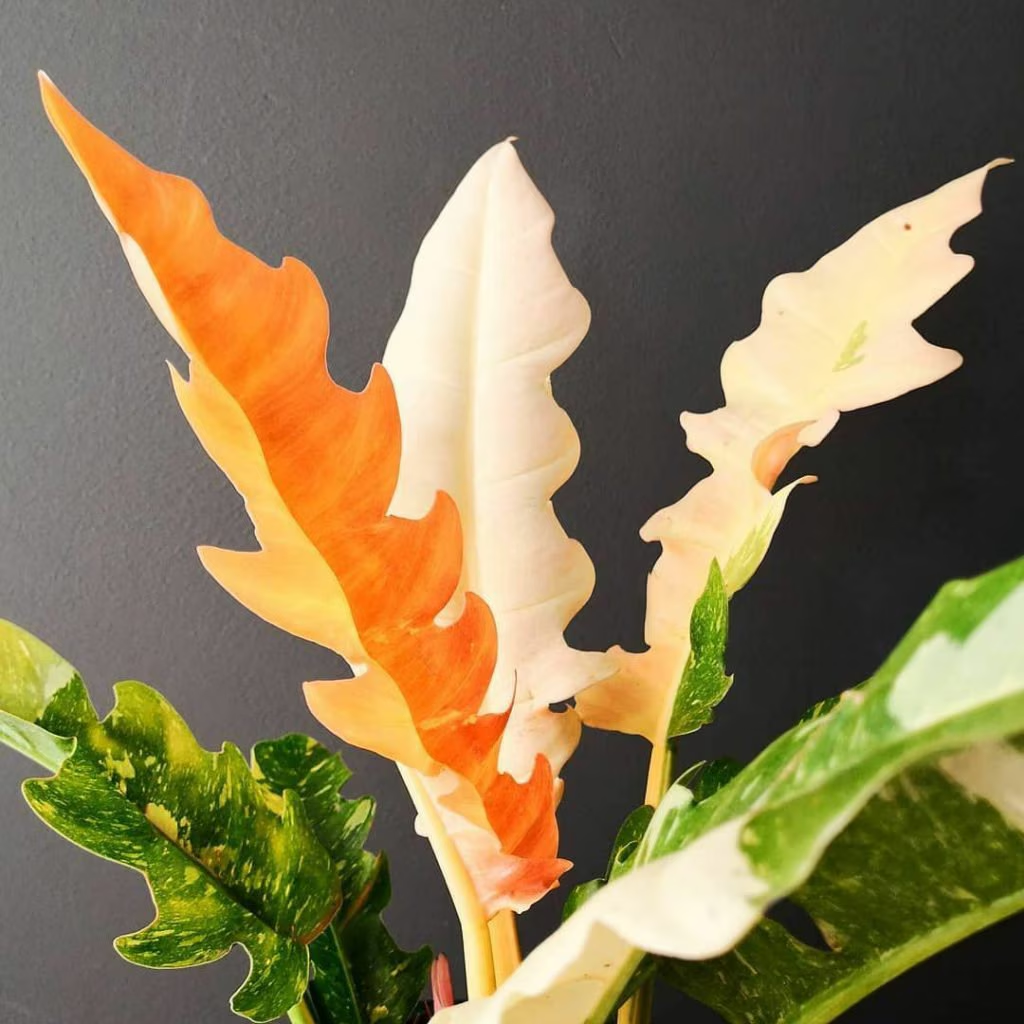The Philodendron ‘Ring of Fire’ is one of the most visually striking and sought-after houseplants. Known for its unique variegated foliage with shades of green, yellow, and red, the Ring of Fire Philodendron adds a touch of drama and exotic beauty to any indoor space. This tropical plant is relatively easy to care for, making it a great choice for both beginners and experienced plant enthusiasts.
In this guide, we’ll explore the essential care tips and considerations to help your Philodendron ‘Ring of Fire’ thrive.
1. Overview of Ring of Fire Philodendron
- Scientific Name: Philodendron ‘Ring of Fire’
- Common Name: Ring of Fire Philodendron
- Family: Araceae
- Origin: Hybrid of Philodendron species, with tropical roots from South America
- Growth Habit: Climbing or trailing vine
- Height: Typically 3–6 feet (90–180 cm) tall when grown indoors
- Leaf Color: Variegated, with green, yellow, orange, and red tones
- Flower: Small, inconspicuous flowers (rarely seen indoors)
- Light Requirements: Bright, indirect light
- Watering Needs: Moderate – allow soil to dry out between waterings
- Temperature: Warm, tropical environment (65°F to 80°F or 18°C to 27°C)
- Humidity: Prefers higher humidity, but can tolerate average indoor humidity
- Hardiness Zone: USDA Zones 10-11 (best suited for indoor environments in cooler regions)
2. Planting Ring of Fire Philodendron
Site Selection:
- Philodendron ‘Ring of Fire’ thrives best in a location with bright, indirect light. Too much direct sunlight can scorch the leaves, especially the lighter, variegated parts. If grown in lower light, the variegation may not be as pronounced, and the plant might become leggy.
- Temperature: It prefers temperatures between 65°F and 80°F (18°C to 27°C) and does not tolerate cold temperatures well. Avoid placing the plant in areas with cold drafts or temperature fluctuations.
- Humidity: This plant is native to tropical environments, so it thrives in higher humidity. A humidity level of 50-60% is ideal. In drier indoor conditions, consider using a humidifier or placing the plant on a humidity tray to maintain adequate moisture in the air.
Soil:
- Ring of Fire Philodendron prefers well-draining, light, and airy soil. A high-quality potting mix that includes components like perlite, coconut coir, or orchid bark works well to promote good drainage.
- You can also use a mix designed for aroids (which is often formulated for other tropical houseplants) as it ensures proper drainage and aeration for the roots.
3. Watering and Moisture Needs
Philodendron ‘Ring of Fire’ is fairly adaptable when it comes to watering, but it’s important to strike a balance. Overwatering can lead to root rot, while underwatering can cause the plant to dry out.
- Watering Frequency: Water your Ring of Fire when the top 1–2 inches of soil feel dry to the touch. This can typically range from once a week to every 10 days, depending on the season and the humidity level in your home.
- Watering Technique: Water the plant thoroughly, ensuring that water drains out of the bottom of the pot. Never let the plant sit in standing water, as this can lead to root rot.
- Signs of Overwatering: Yellowing leaves or mushy stems are signs that the plant has been overwatered.
- Signs of Underwatering: Brown, crispy leaf edges and wilting are signs of underwatering. If the plant is dehydrated, give it a thorough watering and increase the humidity if necessary.
4. Lighting Requirements
- Ideal Light: Philodendron ‘Ring of Fire’ prefers bright, indirect light. A spot near an east- or west-facing window where the plant receives filtered light is ideal.
- Too Much Light: Direct sunlight, especially midday sun, can scorch the delicate variegated leaves and cause them to lose their colors or become sunburned. If you notice leaf burn or browning on the edges, move the plant to a spot with less intense light.
- Low Light Conditions: While this plant can tolerate lower light conditions, it may lose some of its vibrant variegation, and growth may slow down. To maintain the plant’s colorful leaves, it’s best to provide bright indirect light.
5. Fertilizing Ring of Fire Philodendron
- Fertilizing Frequency: During the growing season (spring and summer), feed your Ring of Fire Philodendron with a balanced, water-soluble fertilizer every 4-6 weeks. Dilute the fertilizer to half strength to prevent fertilizer burn.
- Winter Dormancy: In fall and winter, the plant’s growth slows down, so reduce fertilization or stop entirely during this time.
- Type of Fertilizer: Use a balanced fertilizer with equal amounts of nitrogen, phosphorus, and potassium (such as a 20-20-20 mix). A slow-release fertilizer is another option if you prefer fewer applications.
6. Pruning and Maintenance
Pruning your Ring of Fire Philodendron helps maintain its shape and encourages healthy, bushy growth. You can also use pruning to control its size if it becomes too large for your space.
- Cutting Back: If the plant becomes too leggy or unruly, prune it back by cutting the stems to just above a node (where leaves or branches emerge). This encourages new growth and can help maintain a compact form.
- Cleaning Leaves: Clean the leaves regularly with a damp cloth to remove dust. This will not only keep the plant looking shiny and healthy but also improve its ability to photosynthesize effectively.
- Propagation: Ring of Fire Philodendron can be propagated easily from stem cuttings. Simply cut a healthy stem just below a node, place it in water, and wait for roots to form (usually 2-4 weeks). Once the roots have developed, you can transfer the cutting to soil.
7. Common Pests and Problems
While Philodendron ‘Ring of Fire’ is relatively pest-resistant, it can still encounter some common houseplant pests:
- Spider Mites: These pests thrive in dry conditions and can cause the leaves to become speckled or discolored. To combat spider mites, gently rinse the plant with water and apply insecticidal soap if needed.
- Mealybugs: Mealybugs leave a cottony residue on the leaves and stems. They can be treated with rubbing alcohol or insecticidal soap.
- Aphids: These soft-bodied pests can damage the plant by feeding on its sap. A mild soap solution or a strong jet of water should help remove them.
- Scale: Scale insects appear as small, round bumps on the leaves and stems. They can be scraped off gently with a cloth or treated with insecticidal soap.
Diseases:
- The main disease concern for Philodendron ‘Ring of Fire’ is root rot, which is typically caused by overwatering or poor drainage. To prevent this, ensure the soil dries out between waterings, and make sure your pot has adequate drainage.
8. Repotting Ring of Fire Philodendron
- Frequency: Repot your Ring of Fire Philodendron every 1-2 years, or when the plant has outgrown its pot. Signs that it’s time to repot include roots growing out of the drainage holes or the plant becoming root-bound (i.e., when the roots circle around the bottom of the pot).
- Pot Size: Choose a pot that is 1-2 inches larger in diameter than the current pot to allow the roots room to grow.
- Repotting Tips: When repotting, gently remove the plant from its pot, shake off any old soil, and trim any damaged or rotting roots. Place the plant in the new pot, add fresh potting mix, and water thoroughly.
9. Winter Care
During the winter months, your Ring of Fire Philodendron will enter a period of slower growth. This is normal, and it requires less water and fertilizer. Ensure that it still receives adequate light (preferably bright, indirect light) and maintain a consistent temperature, avoiding cold drafts.
10. Conclusion
The Philodendron ‘Ring of Fire’ is a stunning and relatively low-maintenance houseplant that can bring color and elegance to any home. With its unique variegated leaves, it’s sure to be a conversation starter. By providing the right amount of light, water, and humidity, along with occasional pruning, your Ring of Fire Philodendron will thrive and grow into a beautiful, eye-catching plant.
Whether you’re a beginner or an experienced gardener, this plant is a rewarding addition to your collection. Just be mindful of its watering needs, light preferences, and humidity requirements, and you’ll be rewarded with a striking tropical beauty.


